Cuba
In an effort to close down the prison at Guantanamo Bay, President Barack Obama has called to action one of Washington’s most resourceful lawyers, Clifford Sloan. President Obama and Secretary of State John Kerry are confident in their decision to employ Sloan as the State Department's envoy for Guantanamo's closure. The Huffington Post reports:
"It will not be easy, but if anyone can effectively navigate the space between agencies and branches of government, it's Cliff," Kerry said. "He's someone respected by people as ideologically different as Kenneth Starr and Justice Stevens, and that's the kind of bridge-builder we need to finish this job."
Read more here.
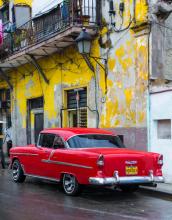
I just returned from a weeklong visit to Cuba. A team of seven people from First Baptist Church Greenville went to be with and learn from our partner church in Guanahay, Cuba — La Iglesia Bautista del Camino. After time in such a colorful country, here are some colorful thoughts of my own for three of our Cuban friends.
If Javier were a color, he would be blue. He is kind. "It is important to look each other in the eyes," he said on Easter morning. "So look into each others’ eyes, really, now, look into each others’ eyes, for at the end of the day you will be able to say that you have looked into the eyes of Christ."

GROWING UP IN the Catholic Church in Cuba, Romy Aranguiz learned to perform acts of charity on limited resources—and to carefully seek out dialogue when the laws of the land seemed to run contrary to her moral compass, or to the government's own professed ideals.
"For me, the church is the best representation of civil society in Cuba. It was probably the only institution that kept a certain distance from the government when there was hardly an opposition," she said in a recent phone interview from her home in Massachusetts.
Now a medical doctor in the U.S., Aranguiz continues to implement those lessons, these days through Cuban Americans for Engagement (CAFE), a movement aimed at broadening U.S.-Cuba relations through citizen exchange, open trade, and diplomatic cooperation.
Like most of CAFE's founding members, Aranguiz is a Cuban Gen Xer who obtained her education on the island and migrated to the U.S. as an adult. She developed a penchant for blogging while pursuing a professional career and obtaining U.S. citizenship.
CAFE's members are focused on breaking the silence they experienced in communist Cuba—and the silence they encountered as new immigrants to the U.S., where the Cuban-American agenda was often set by older exiles with no interest in a U.S.-Cuba dialogue.
"I think CAFE is having a positive impact on previous generations of Cuban Americans and Latinos in the U.S., descendants from first migratory waves," says CAFE board member María Isabel Alfonso, a professor at St. Joseph's College in New York. "CAFE has come to fill a void, as it values diplomacy and engagement over a confrontational, Cold War mentality."
The cars in Cuba fascinate me. Where else in the world can one see a classic 1956 Oldsmobile, a shiny 1957 Chevy, and a 1970 VW bug alongside a new Audi and modern Chinese tour buses?
Our guide said there are four generations of cars in Cuba. First are those pre-revolutionary American cars—the vintage Chevys, Fords, Oldsmobiles, and Studebakers from the 1950s that somehow keep running. Then came the Russian-made Ladas, the small, ugly, square compacts that look like Fiats stripped of any Italian design.
By the ’70s and ’80s, Japanese and other Asian cars started trickling into Cuba, and they became the auto of choice after the fall of the Berlin Wall. Then, in the last decade, the more expensive European cars began showing up. More recently, a fleet of fancy buses, mostly from China, has arrived to shuttle around the 2.5 million tourists now visiting the island each year (and improve public transportation in general).
The cars, of course, reflect the stages of Cuba’s economic relationship with the outside world: the embargo from the U.S., its initial reliance on all things Russian, then growing global trade, followed by the influx of European tourists, and the recent economic resurgence of China.
Cars can now be bought and sold by Cubans. This is one example of dramatic new economic policies, approved last April, being instituted in Cuba. Dr. Osvaldo Martinez, director of Cuba’s World Economy Research Center, called these changes “shock therapy,” like that being experienced by Greece, Spain, and many countries. Cubans should no longer “idolize” the Cuban economic model, Martinez said. Salaries have been increasing faster than productivity. Foods are being imported that could be produced domestically, but weren’t because of the inefficiencies of centralized, Soviet-style agriculture. There has been an “exaggerated number of state employees,” and massive layoffs have been occurring. At times Martinez nearly sounded like a Republican.

Following Pope Benedict XVI's recent trip to Cuba, U.S. Catholic bishops are pushing the State Department to lift the 50-year Cuban embargo in order to improve religious liberty and human rights for the Cuban people.
In a Tuesday (April 17) letter to Secretary of State Hillary Rodham Clinton, Bishop Richard E. Pates of Des Moines, Iowa, the chairman of the bishops' Committee on International Justice and Peace, pressed the Obama administration to pursue “purposeful engagement rather than ineffective isolation” with Havana.
From the fall of the Berlin Wall in November 1989 to the dissolution of the Soviet Union in December 1991, the Cold War ended. But U.S. policymakers apparently still haven’t gotten the news.
This meeting of the Summit of the Americas in Cartagena, Colombia, last weekend ended without the usual official declaration because U.S. policy refuses to include Cuba, while a broad range of other governments in the Americas supports an invitation. The final vote was 32-2 for Cuba’s inclusion in future meetings, with only the U.S. and Canada opposed.
Reuters noted: “U.S. insistence that Havana undertake democratic reforms before returning to the hemispheric family led to a clash with a united front of leftist and conservative governments that see Washington's policy toward Cuba as a relic of the Cold War.”
It’s long past time for the U.S. to realize that the Cold War is over, that Cuba exists, and that inclusion will foster change faster than exclusion. Even the Vatican realizes that, as Pope Benedict’s recent trip to Cuba demonstrated.
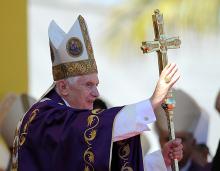
Pope Benedict XVI ended his three-day visit to Cuba on Wednesday (March 28) with an appeal for more religious freedom for the Catholic Church, ahead of a highly anticipated meeting with the island's historic leader, Fidel Castro.
And while he stopped short of openly criticizing the island's communist regime during the trip, Benedict nonetheless said Cuba needed "change" and a "renewed and open society."
The pope celebrated Mass on Wednesday in Havana's Revolution Square for about 300,000 people, according to the Vatican's top spokesman, the Rev. Federico Lombardi.
Cuban President Raul Castro was in attendance and joined in the crowd's applause when the pope entered the stage.
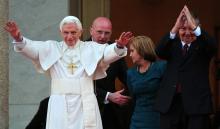
Pope Benedict XVI’s 3-day visit to Cuba began Monday, when President Raul Castro greeted the pontiff at the airport of Santiago de Cuba. The arrival was fairly quiet, but the evening Mass in Santiago’s plaza was attended by an estimated 200,000 Cubans. The pope's long-awaited visit attracted news coverage from around the world, mostly focusing in the pope’s message.
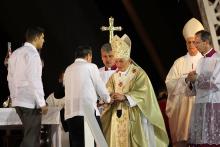
VATICAN CITY--Pope Benedict XVI arrived in Cuba on Monday (March 26), renewing the Catholic Church's pledge to "work tirelessly to better serve all Cubans" as the island strives to "renew and broaden its horizons."
Benedict landed in Santiago de Cuba, east of Havana, arriving from Mexico for the second leg of his weeklong visit to Latin America. President Raul Castro came to personally greet the German pope before Benedict was scheduled to celebrate Mass in the city's Revolution Square.
In his speech during the airport welcome ceremony, Benedict said he carried with him "the just aspirations and legitimate desires of all Cubans," including those of "prisoners and their families."
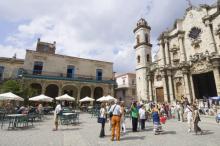
VATICAN CITY--Two weeks before Pope Benedict XVI was scheduled to touch down in Cuba, a small group of protesters occupied a church in central Havana, asking that a message with their requests be delivered directly to the pope.
Their action was swiftly condemned by church authorities as "illegitimate and irresponsible." The group remained in the church for two days, and only left Thursday (March 15) after being assured by a top church leader that they could return home without police interference.
The episode illustrates the challenges that Benedict will find in Cuba during a March 23-29 trip that will also include a stop in Mexico. But it also highlights the good relationship that the Catholic Church has built in recent years with the island's communist regime.
The trip will be the pontiff's second visit to Latin America, which is home to almost half of the world's Catholics. Benedict visited Brazil in 2007.
During his trip, the pope will meet political leaders from both countries and, according to the Vatican's top spokesman, the Rev. Federico Lombardi, he might even have a brief encounter with longtime Cuban leader Fidel Castro, though it is not on the official agenda yet.
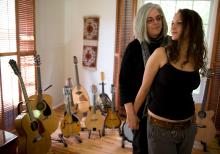
WASHINGTON--Pope Benedict XVI will use his upcoming trip to Cuba to press for the release of Alan Gross, a Jewish man who has languished in a Cuban jail for more than two years, according to Gross' supporters.
That's the latest Ronald Halber, executive director of the Jewish Community Relations Council of Greater Washington, said he has heard through Vatican back channels.
In recent weeks, the council has circulated a petition asking the pope to intercede on Gross' behalf when he visits the island on March 26-28.
"He represents humanitarianism and cherished values, and hopefully his presence could help lead to Alan Gross' release," Halber said.

Earlier this month, Sojourners board member and former General Secretary of the Reformed Church in America, Wes Granberg-Michaelson, journeyed to Cuba with a delegation of religious leaders from the National Council of Churches.
Their visit culminated in a joint declaration celebrating signs of unity between the U.S. and Cuban churches. Sixteen representatives of U.S. National Council of Churches member communions were in Cuba November 28 through December 2 meeting with Cuban church and political leaders, including President Raúl Castro.
The delegation, which Cuban church leaders said was the highest ranking U.S. church group to visit the island in their memory, was led by the Rev. Dr. Michael Kinnamon, NCC general secretary. The joint statement by the churches declared that normalization of relations between the U.S. and Cuba would be in the best interest of both nations, and the leaders called for the resolution of three humanitarian issues “which cause unjustifiable human misunderstanding and suffering.” Foremost among the issues is the 53-year-old U.S. economic embargo of Cuba that dates back to the administration of President John F. Kennedy.
Read a series of dispatches from Granberg-Michaelson inside God's Politics.
Twenty-five Christian peacemakers, members of Witness Against Torture, walked 50 miles from Santiago, Cuba, to the gates of the controversial U.S. Naval Base at Guantánamo Bay in December to protest the treatment of prisoners detained there.
I began 2003 in Cuba. It's a good practice to launch a new year with fresh insights. Cuba did not disappoint. It was my first visit to the island nation.
One outcome of the circus surrounding the Elian Gonzalez case has been increased scrutiny of U.S.-Cuba policy and renewed hopes for a better relationship with the island nation.